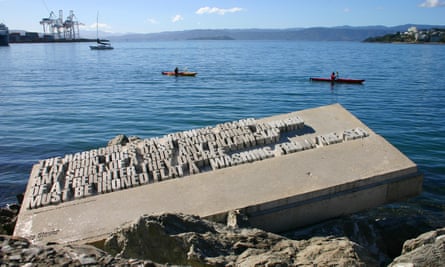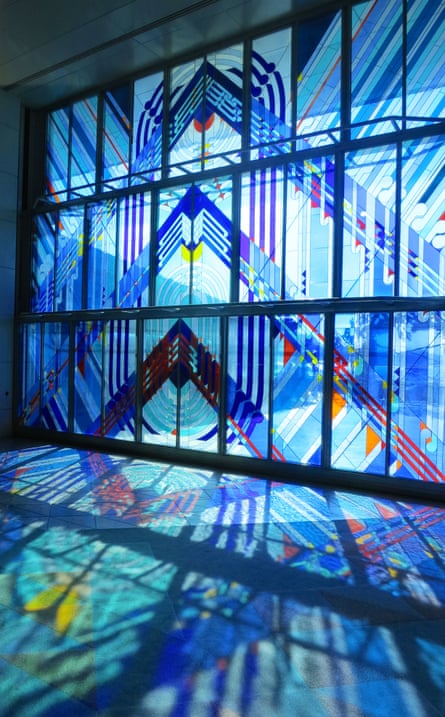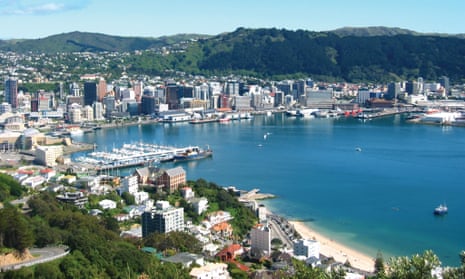Creative, well caffeinated and culinarily blessed, Wellington is surprisingly compact. The central area of New Zealand’s capital is just 2km across, which means it’s a cinch to get around on foot – you’re usually no more than a 10-minute stroll from the next place you want to be.
The Guardian’s product and service reviews are independent and are in no way influenced by any advertiser or commercial initiative. We will earn a commission from the retailer if you buy something through an affiliate link. Learn more.
You’ll need every bit of exercise you can get to stoke your appetite: Wellington is packed with cool-as cafes, boutique food factories and exceptional restaurants. It also has craft beer, a couple of critically endangered old birds and a colossal squid. Yep, everything you want in a city break.
Here’s a suggested itinerary for a weekend of leisurely exploring and a lot of eating (if you don’t adore food, maybe you should try another city). With everything so close, there’s plenty of time to just sit and smell the coffee. All prices are in New Zealand dollars.

Friday
5pm: check in
Check into the InterContinental Wellington (from $260 for a king room) in Grey Street, an 8km drive from the airport in a prime position one street back from the harbour. Glam, friendly and newly refurbished, the InterCon has beds to drown in.
If you don’t fancy forking out for five-star luxury, the Cambridge Hotel (from $90 for a twin room with a shared bathroom) is a comfortable pub near the Courtenay Place entertainment district. Airbnb has a host of good-value options as well.
7pm: dinner
Just steps from the InterCon in Post Office Square is Charley Noble, a big and bustling bistro helmed by chef and owner Paul Hoather that specialises in wood-fired cooking. Mains are about $30, with the most expensive dish at $56 – a 500g grass-fed Prime Angus ribeye on the bone. I visit during the annual Wellington on a Plate culinary festival so sample a special three-course menu. The standout dish is a superbly tender charcoal-roasted chicken breast on a smear of cauliflower with truffle butter. My dinner companion and I confuse the wait staff by ordering cocktails after our desserts. They look so good – and we don’t want the night to end.

Saturday
8am: breakfast
Owned by brothers Jesse Simpson and Shepherd Elliott, Ti Kouka Cafe in Willis Street is one of those special places where passionate people make magic happen. Jesse runs front of house and cranks out the coffees, while in the kitchen Shep – who has worked at top Wellington restaurant Logan Brown and for the Sydney-based superstar chef Tetsuya Wakuda – serves up breakfast, brunch and lunch with a heavy emphasis on local, sustainable and organic meats and produce. Shep is lit up by food: here he talks about his cooking philosophy and the origins of Ti Kouka. Breakfast offerings include warm white polenta porridge with roasted rhubarb, pistachios and cinnamon; sautéed beans and grains with goats curd, lemon, kale, mint, harissa and a poached egg; a cheese omelette with caramelised leeks, sumac, tamarillo chutney and rocket; and a dry-cured bacon sandwich. The bread comes from the brothers’ other venture, the Leeds Street Bakery, which is famed for its to-die-for salted caramel cookies.
The timing of my visit means I’m able to taste “Aporkalypse Now”, Ti Kouka’s entry in Burger Wellington, the city’s annual battle of the bun and one of the food festival’s most popular events. Combining slow-roasted bourbon-glazed pork shoulder, ginger-ale bacon and apple with smoked barbecue mayonnaise, hot sauce, crackling and pickles, it’s a tender, juicy, crunchy fistful of yum. If you don’t make it to Ti Kouka for breakfast, get there for lunch.
9.30am: walking tour
The rallying point for Zest Food Tours’ daily Capital Tastes outing is a block away from Ti Kouka at the i-SITE visitor information centre, at the corner of Victoria and Wakefield streets. $179 buys you three and a half hours of wandering, sipping and nibbling in the company of a fervent Wellingtonian, learning about the city’s history, architecture and activism.
My guide is Stephanie, a Dane who moved here 25 years ago for love – then fell in love all over again with her new home town. She has a few theories about what makes its culinary scene special: for one, there are about 20 coffee roasters for Wellington’s 230,000 people, and “good caffeination makes for creativity”. Secondly, “it’s a windy city, so there’s plenty of cross-pollination” in the tight-knit food community.
We cross the City to Sea Bridge – part-pedestrian bridge, part-public artwork – that links Civic Square with the waterfront. Our first stop is the headquarters of Mojo, one of those coffee roasters, in a historic shed on the quay. We see behind the scenes, then sit down for a cup of the house blend, Dr Mojo’s Medicine, with a chocolate florentine.
Next we hit Gelissimo, causing a buzz with glow-in-the-dark gelato created for Welly on a Plate and the Lux light festival. Then we move on to Hannahs Laneway, home to Fix & Fogg peanut butter, Wellington Chocolate Factory and the Leeds Street Bakery, among others. We’re meeting the makers and sampling all the way.
We end up at Moore Wilson’s, a cash-and-carry business where Wellington’s chefs shop. It stocks a simply staggering array of food from across the country and around the world. I’m not sure the tour always ends here, but Stephanie, recognising a kindred spirit, wants me to see the mind-blowing produce, the range of game, the seafood and meats, the cheese counter, the patisserie, the dessert supplies … On a trip to Waiheke Island, I learnt that Kiwis know their food, but this place is beyond my imaginings. I take home a packet of freeze-dried pineapple powder, simply because I’d never known such a thing existed.
1pm: Cuba Street
After a tour like that, there’s precious little chance you’ll be wanting lunch, so now is a good time to check out Cuba Street, six or so partly pedestrianised blocks of boutiques, buskers and bohemia. (This being Wellington, there are bars and eateries galore if you flag.)
2pm: craft beer
The city’s craft beer scene has exploded in the past five years. A top place to sample a drop is the Third Eye, Tuatara brewery’s “temple of taste”, in Arthur Street. On Saturdays, it offers an hour-long $35 tasting experience that pairs four beer styles with small bites.
There’s also a warm welcome at Golding’s Free Dive in Leeds Street, a quirky room decorated with brightly coloured old bits and pieces – there are bucket lightshades and the awning over the bar is made of old skis. Food can be ordered from the neighbouring Pizza Pomodoro.

3.30pm: Te Papa
No trip to the Kiwi capital is complete without an hour or more in the national museum, the Museum of New Zealand Te Papa Tongarewa. There’s an earthquake simulator, a Māori marae (meeting place), the skeleton of a pygmy blue whale and the half-tonne corpse of the largest colossal squid captured to date. On my visit, a guide points out a design flaw in this monster of the deep: its throat runs through the centre of its doughnut-shaped brain, limiting how much it can swallow without risking brain damage. There’s a lesson here for the food fan on the loose in Wellington.
I also brave the crowds queuing for Te Papa’s hit exhibition, Gallipoli: The Scale of Our War, which brings to life the Anzac campaign through the stories of eight New Zealanders. Each of them is portrayed at a pivotal moment on a monumental scale – 2.4 times human size – in stunning sculptures created by Weta Workshop, the special effects company that worked on Peter Jackson’s The Lord of the Rings Trilogy. It’s an immersive and powerful show. Entry is free.
8pm: dinner
There are two suggestions for dinner tonight (bookings are advisable for both).
The first is a much-loved veteran of Wellington’s fine-dining scene, Logan Brown, housed in a grand old bank at the top of Cuba Street and boasting a bar that doubles as a fish tank. On Saturdays, there’s a $49 three-course bistro menu, a $105 five-course chef’s tasting menu and a $135 seven-course degustation menu, all with the option of matched wines. The latter two feature Logan Brown’s sunshine-yellow signature dish, paua ravioli with coriander, basil and lime beurre blanc, topped with crunchy kumara strips.
At the second option, Ortega Fish Shack and Bar in Majoribanks Street, which runs off Courtenay Place, attentive staff serve up stunningly fresh, imaginative seafood dishes. Sample mains: smoked white warehou with radish kimchi, slow-cooked egg, yuzu mayo and black pudding crumb; pan-roasted gurnard with crayfish butter, rigatoni, Parma ham, manchego and truffle oil; and groper with arroz negro, smoked mussels, cockles, chorizo, almonds and scampi mayo. There is a beef fillet and a gruyère soufflé for the non fish-friendly. All are in the $34 to $39 range.
Sunday

8am: breakfast
The Flight Coffee Hangar in Dixon Street is an airy, industrial space run by self-professed coffee geeks who cook up a damn fine breakfast. There are crumpets, eggy options, steak, black pudding and bagels, but at the heart of the menu is the “build your own brekkie” list. For $16.50 I put together perfectly rare pan-fried salmon, avocado smash and a huge homemade hash brown. Heaven. Oh, and the coffee is incredible. I try the house Bomber blend with malt, chocolate and caramel notes, and another described as “dessert in a cup”, with orange, fig and plum flavours. It’s the first flat white I’ve managed to drink in Wellington without half a teaspoon of sugar (New Zealanders like their coffee STRONG).
9am: art gallery
Opposite the i-SITE in Civic Square is City Gallery Wellington, an elegant contemporary art centre housed in the former public library. It offers exhibitions, guided tours, artists’ talks and live performances. Entry is free.
On my visit, members of the public are sitting at a 12-metre table creating, destroying and re-creating towering structures using thousands of white Lego pieces. It’s the Danish artist Olafur Eliasson’s The Cubic Structural Evolution Project – part of the gallery’s Demented Architecture program – and it’s hugely popular.
11am: market

After you’ve had your fill of art, wander past Te Papa for Sunday’s Harbourside market, where locals stock up on fruit and veg. There are providores alongside the produce purveyors, plus 40-or-so food trucks and vans offering dishes from around the world, including Cambodia, Chile, Hungary and the Philippines. Roti vans are doing a roaring trade and whitebait patties are selling like small, fishy hotcakes. Odds are you’ll find elevenses and lunch here.
1pm: cable car and Zealandia

Time to get away from it all – well, 5km up the road – to Zealandia, a wildlife sanctuary with a difference.
There’s a free shuttle from the i-SITE or, for a more scenic trip, hitch a ride on Wellington Cable Car from Lambton Quay. It takes you up through flashing LED light-filled tunnels to Kelburn lookout, beside the city’s botanic garden. The 25ha garden, established in 1868, has lovely winding walkways and views over the city.
There’s second shuttle stop at the lookout. Jump aboard to see a park in another style altogether, a 225ha “urban ecosanctuary” ringed by a predator-proof fence.
Here, in a sheltered valley, some of New Zealand’s rarest birds and reptiles live “in the wild”, along with bats, fish, insects and frogs. The aim is to showcase 80m years of New Zealand’s natural history and turn the clock back 800 years, before the first Polynesian explorers reached these islands.
For a $17.50 entry fee, I see kākā parrots, “living fossil” tuatara lizards, and Zealandia’s two elderly takahē, a flightless bird once thought extinct. They crop grass with a slightly irritated air – you might be cranky too if a bunch of camera-wielding tourists were interrupting your afternoon tea.
As I hike further into this wilderness 10 minutes from the city, the only sounds are birdsong and the wind stirring the tops of pine trees lining the ridge. It’s a wonderful place to decompress – the perfect break from the perfect city break.
Guardian Australia was a guest of Positively Wellington Tourism


Comments (…)
Sign in or create your Guardian account to join the discussion